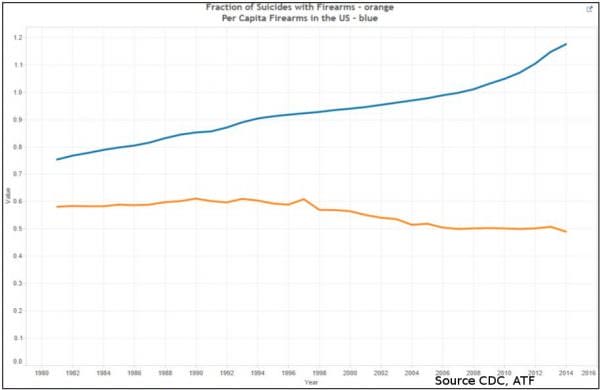PA Bill Number: HB2138
Title: In firearms and other dangerous articles, providing for the offense of negligent marketing.
Description: In firearms and other dangerous articles, providing for the offense of negligent marketing. ...
Last Action: Referred to Judiciary
Last Action Date: Jan 14, 2026
Fraction of Suicides with Firearms Compared to per Capita Firearms in U.S.A. :: 10/24/2016
Arizona – -(Ammoland.com)- The number of firearms in private hands has been rising for at least 70 years. During the last 20, the numbers of murders, murders with guns, and violent crime with guns has been dropping sharply. It has become very hard to say that more guns equal more crime with a straight face. Fatal gun accidents are at an unprecedented low. The rate of fatal gun accidents has dropped 94% in 85 years.

The response of those who wish to disarm the public has been to focus on suicides. They lump in suicides with murders and accidents and call the whole mismash “gun violence”. But if you look at the actual numbers of suicides committed with guns, you come to an understanding at odds with the gun haters narrative. As the number of guns per capita has increased, the percentage of suicides with guns has dropped.
The percentage of suicides with guns held steady, with a little spike in 1997, likely associated with a record keeping change to tighten up the data input. But from 1997 on, there has been a steady decline in the percentage of suicides committed with guns.
Guns were chosen for .58 of all suicides in 1981, the fraction of suicides committed with guns rose to a high of .61 from 1990 to 1997 (the high point of homicides was 1993-95), then started a long decline ending at .49, the record low, in 2014.
More guns have not increased the fraction of suicides committed with guns over several economic cycles.
The rates of suicide used are those from the Center for Disease Control WISQARS data base. The CDC adjusted the rates to account for changing age distributions. The age correction does not make a large difference. It removes the variation associated with changing percentages of various age groups over the decades examined.
The number of private firearms was calculated from the Bureau of Alcohol, Tobacco, Firearms, and Explosives (ATF) numbers, using the method developed by Newton and Zimring, expanded on by Gary Kleck in “Point Blank: Guns and Violence in America”. Census figures were used to determine the per capita numbers.
As there are many easily substituted methods for committing suicide, this is not surprising. Many nations with small numbers of guns and political gun control that is very harsh, have suicide rates far higher than the United States.
Suicide is a matter of many other factors that operate independent of the number of guns in society. When someone commits suicide with a gun, it is fairly obvious. When someone commits suicide with a car or motorcycle, or by lying down on a railroad track, it is not nearly as obvious and is likely to be ruled accidental. A correspondent on The Truth About Guns noted that suicides in Australia did not drop as initially reported. They were misclassified.
In short not only were half of decreased gun suicide immediately replaced by other means known suicide – Australia also saw a sharp and immediate increase in self caused fatal “accident” death associated with suicide. Unless one posits another reason for an immediate increase in Australians driving alone into abutments and trees, taking “accidental” fatal overdose, falling onto train tracks, falling out of windows, in 1997s and after, it is clear there was no drop in suicide, just a increase in suicide by replacement methods and an increase suicide means that were incorrectly tabulated.
The correspondent backs up his assertions with this link and quote:
”What that revision of ABS data will show us is that really we have gone nowhere in terms of overall reductions from the peaks in suicide rates in the early 1990s, and we have certainly gone nowhere among reducing suicide in indigenous populations. They remain four times higher overall,” Professor Mendoza said.
Governments had done little more than the bare minimum to prevent deaths, said Dawn O’Neil, chief executive officer of Lifeline.
”Once we got confirmation the rates were not coming down … the Government didn’t want to know, politically they wanted to believe that the suicide rates were falling.”
It sounds much like the United States. “Studies” that support the political narratives preferred by the powerful social engineers, are touted. Those that do not follow the party line, are sidelined.
Claiming that harsh restrictions on guns will reduce suicides is a dead end. It is being used as an emotional tool to obtain something else that is desired, a disarmed population.
©2016 by Dean Weingarten: Permission to share is granted when this notice is included.
About Dean Weingarten;
Dean Weingarten has been a peace officer, a military officer, was on the University of Wisconsin Pistol Team for four years, and was first certified to teach firearms safety in 1973. He taught the Arizona concealed carry course for fifteen years until the goal of constitutional carry was attained. He has degrees in meteorology and mining engineering, and recently retired from the Department of Defense after a 30 year career in Army Research, Development, Testing, and Evaluation.



